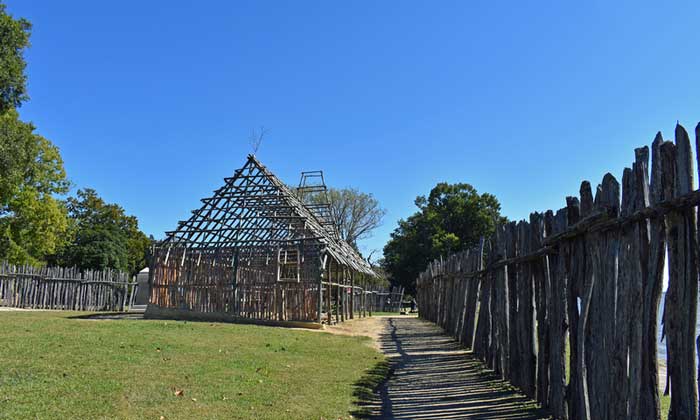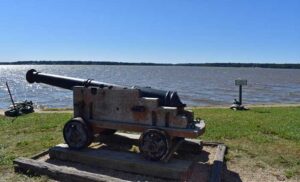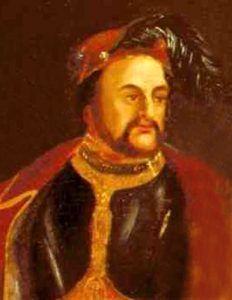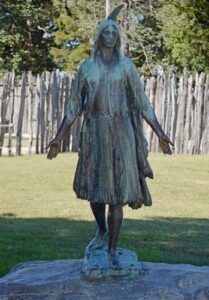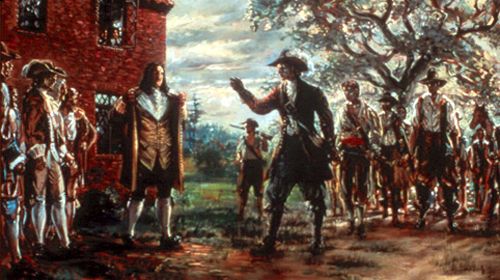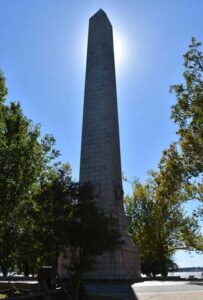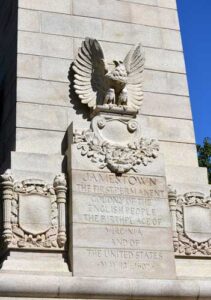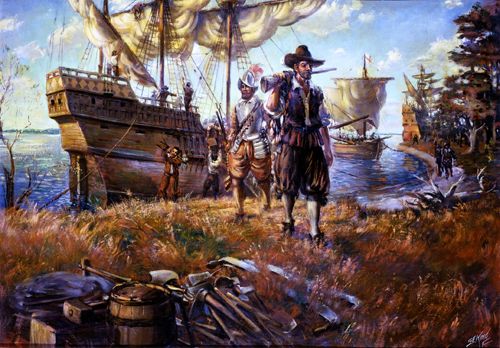
On May 13, 1607, the Jamestown colonists came ashore with the first permanent English settlement in North America. Painting by Sidney E. King, courtesy of Colonial National Historical Park.
Historic Jamestown, Virginia, is the site of North America’s first permanent English settlement. It represents the very foundations of who and what we are as a people and a nation. Although there were other European settlements in America before Jamestown, our language, customs, and laws come from our English ancestry. Jamestown is the beginning of America.
Before the English or any Europeans arrived, Native Americans occupied the continent for thousands of years, and archeological evidence indicates that they utilized the Jamestown region for over 10,000 years. England was a latecomer to American exploration. The Vikings explored North America as early as the 10th century, followed by Christopher Columbus in 1492 and numerous others.
The first attempt at English settlement was the fabled Lost Colony of Roanoke in 1587. Twenty years later, in 1607, England established its first permanent colony, Jamestown, through a joint-stock company known as the Virginia Company.
It all began on December 6, 1606, when three ships —the Susan Constant, the Godspeed, and the Discovery —left England bound for America. In early 1607, 104 Englishmen and boys arrived in North America and began searching for a settlement. On May 13, 1607, they chose Jamestown, Virginia, named after their King, James I. The settlement became the first permanent English settlement in North America.
The site for Jamestown was chosen for several reasons, all of which met the criteria that the Virginia Company, which funded the settlement, said it would follow. The site was surrounded by water on three sides (it was not yet entirely an island) and was far inland, making it easily defensible against possible Spanish attacks. The water was also deep enough that the English could tie their ships to the shoreline; at the time, the site was uninhabited by Native Americans.
Once the spot was chosen, the instructions sent by the Virginia Company, which included a list of the council members selected by the company, were read. The names had been kept in sealed boxes on the ships, not to be read until a site was chosen. The first President of the new Virginia colony was Captain Edward Maria Winfield. The other six council members included Bartholomew Gosnold, Christopher Newport, John Martin, John Ratcliffe, George Kendall, and Captain John Smith.
By June 15th, a fort was completed. It was triangle-shaped, with a bulwark at each corner, holding four or five pieces of artillery. The settlers were now protected against any attacks from the local Powhatan Indians, whose hunting land they were living on. Before the Jamestown immigrants’ arrival, relations between the newcomers and the Powhatan Indians were already mixed. On June 22nd, Captain Christopher Newport left for England to get more supplies for the new settlement.
When the new settlers first arrived, they were greeted by friendly Indians who provided them with lavish feasts and maize. However, as the English, lacking the inclination to grow their food, became hungry, they began to strong-arm the natives for more and more supplies. This immediately led to a deterioration in relations and eventually to conflict.
Not long after the Captain had sailed, the settlers began succumbing to various diseases. They were drinking water from the salty or slimy river, which caused the death of many. The death toll was high, with the men dying from swellings, malaria, fever, famine, and sometimes, in altercations with the Indians. Food was running low, even though Chief Powhatan had begun sending food gifts to help the English. If not for the Powhatan Indians’ help in the early years, the settlement would most likely have failed.
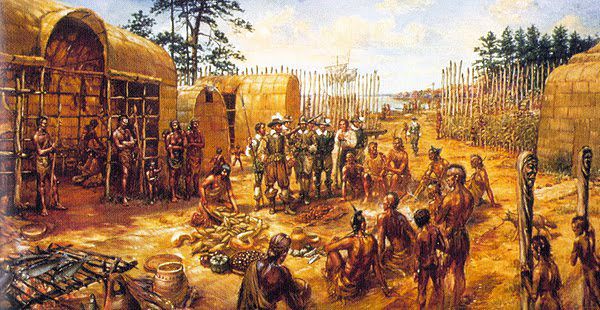
Jamestown, Virginia Indians
By late 1609, the relationship between the Powhatan Indians and the English had soured, as the English demanded too much food during a drought. The winter of 1609-10 became known as the “Starving Time.” The English had become afraid to leave the fort, fearful that the Indians would kill them. As a result, they ate anything they could, including various animals and leather from their shoes and belts, and even resorted to cannibalism after their fellow settlers died. By early 1610, most Jamestown immigrants had died due to starvation and disease, estimated at 80-90%.
In May 1610, shipwrecked settlers who had been stranded in Bermuda finally arrived at Jamestown. Part of a fleet sent the previous fall, the survivors used two boats built in Bermuda to get to Jamestown. Sir Thomas Gates, the newly named governor, found Jamestown in shambles with the fort’s palisades torn down, gates off their hinges, and food stores almost non-existent. The decision was made to abandon the settlement. However, less than a day after leaving, Gates and the Jamestown survivors were met by news of an incoming fleet. The fleet was bringing their new governor, Lord Delaware, and the men returned to Jamestown.
In 1612, John Rolfe, one of many shipwrecked in Bermuda, helped turn the settlement into a profitable venture. He introduced a new strain of tobacco from seeds he brought, and it became the long-awaited cash crop for the Virginia Company, which wanted to make money off its investment in Jamestown.
On July 30, 1619, newly appointed Governor Yeardley called for the first representative legislative assembly. This was the beginning of representative government in what would become the United States of America. The first documented Africans were brought to Virginia on a Dutch privateer ship that same year. The Dutch traded some 20 Africans for food stores from the English. These slaves provided the labor needed for tobacco production.
Also, in 1619, the Virginia Company recruited and shipped over 90 women to become wives of English immigrants so that families could be started. Though more than a hundred women had arrived in prior years, it was not until 1619 that establishing families became a primary focus.
Peace between the Indians and Pocahontas and John Rolfe ended in 1622. In March that year, the paramount chief, Opechancanough, planned a coordinated attack against the English settlements. He was tired of the English encroachment on Powhatan lands. Jamestown escaped being attacked due to a warning from a Powhatan boy living with the English; however, some 350-400 of the 1,200 area settlers were killed. After the attack, the Powhatan Indians withdrew, as was their way, and waited for the English to learn their lesson or pack up and leave. Once the English regrouped, they retaliated, and fighting between the two peoples continued for the next decade until a tenuous peace was reached in 1632.
On May 24, 1624, the Virginia Company’s charter was revoked by King James I due to overwhelming financial difficulties and political pressures, and Virginia became a royal colony, which remained until the Revolutionary War. This shift in control did not change the English policy towards the Indians. Despite peace being declared in 1632, English encroachments on Powhatan lands continued undiminished as more settlers arrived.
In April 1644, Chief Opechancanough planned another coordinated attack, which resulted in the deaths of another 350-400 of the 8,000 area settlers. The attack ended when Opechancanough was captured in 1646, taken to Jamestown, shot in the back by a guard against orders, and killed. His successor later signed the first treaties with the English, making the Powhatan Indians English subjects.
Bacon’s Rebellion in 1676 brought further struggles to Jamestown. The settlers were unhappy about their tobacco being sold only to English merchants due to the Navigation Acts, high taxes, and attacks on outlying plantations by American Indians. As a result, Nathaniel Bacon recruited about 1,000 settlers to join him in addressing the “Indian Problem.” Bacon forced Governor Berkeley to give him an official commission to attack the American Indians responsible for the attacks on the outlying plantations. However, Bacon and his followers did not differentiate between those tribes responsible for the attacks and those loyal to the English. As a result, Governor Berkeley declared Bacon a rebel, and civil war erupted in the colony. In September, Bacon and his followers set fire to Jamestown, destroying 16 to 18 houses, the church, and the statehouse. Not long after, in October, the Rebellion ended with Nathaniel Bacon’s death. Eventually, many rebels were captured, and Governor Berkeley hanged 23.
After Bacon’s Rebellion, another treaty was signed between the English and the Virginians. More tribes were part of this treaty than in the 1646 treaty. The treaty established additional reservation lands and reinforced an annual tribute payment of fish and game that the tribes had to pay to the English.
In 1698, fire struck Jamestown again when a prisoner awaiting execution in the nearby prison started a blaze. The fire destroyed the prison and the statehouse, though many public records were saved. In 1699, the government and capital were moved from Jamestown to the Middle Plantation, renamed Williamsburg in honor of King William III’s reign. A new Capitol building and “Governor’s Palace” were erected there in the following years.
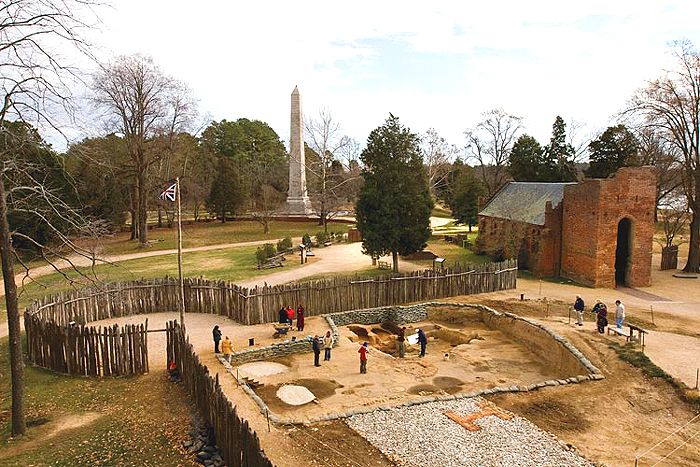
Jamestown, Virginia, today.
With the capital moving to Williamsburg, the old town of Jamestown began to disappear slowly, though farmers continued to live on the island. Those who lived in the general area attended services at Jamestown’s church until the 1750s, when it, too, was abandoned.
Today, Jamestown Island is a National Historic Site where visitors can walk in the steps of Captain John Smith, Pocahontas, and the other early settlers of the first thriving English colony.
Preserved by the National Park Service and Preservation Virginia, the National Historic Site features an archaeological museum, the Archaearium, and guided and self-guided tours. Sites include the site of the original 1607 James Fort, the 17th-century church tower, and the location of the 17th-century town. The Jamestown Glass House can also be visited, allowing visitors to make glass much as it was done centuries ago at Jamestown. It is part of the Colonial National Historical Park, which provides views of both Old Towne and New Towne, east of the fort, which was first surveyed in the 1620s.
Because of its strategic location, Jamestown was utilized during the American Revolution. The battle of Green Spring took place only a short distance from Jamestown. During the Civil War, Confederate forces occupied Jamestown and fortified it with five earthworks.
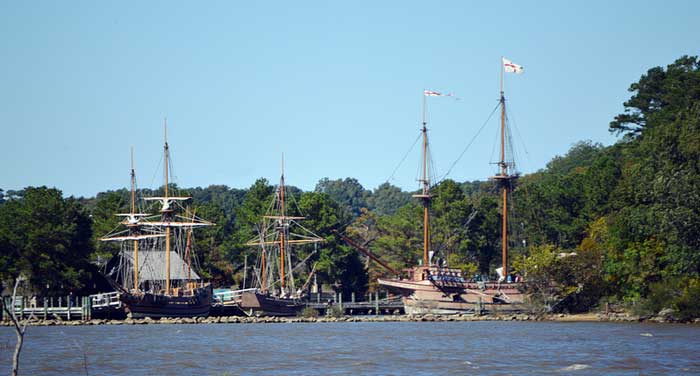
Replicas of the three ships that carried settlers to the Virginia settlement in 1607 are docked in the harbor. Photo by Dave Alexander.
More Information:
Jamestown National Historic Site
P.O. Box 210
Yorktown, Virginia 23690
757-856-1200
Compiled and edited by Kathy Alexander/Legends of America, updated November 2025.
Also See:
Nathaniel Bacon — First American Rebel
Settling of America – The Old Dominion
Source: National Park Service

